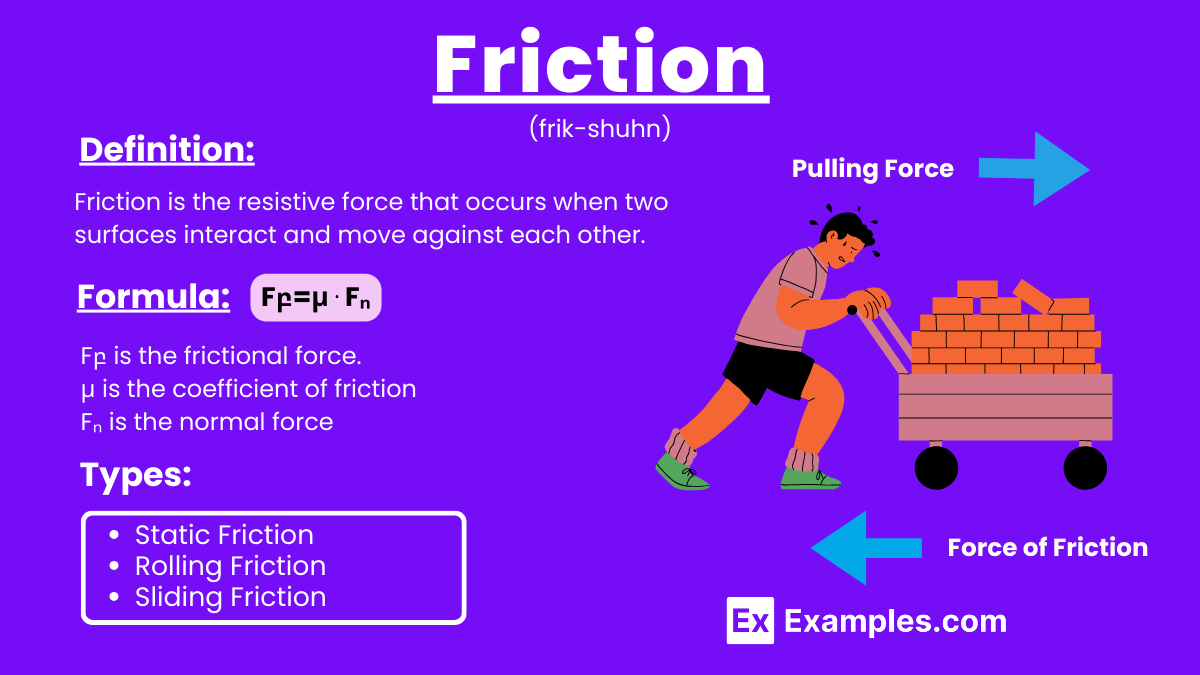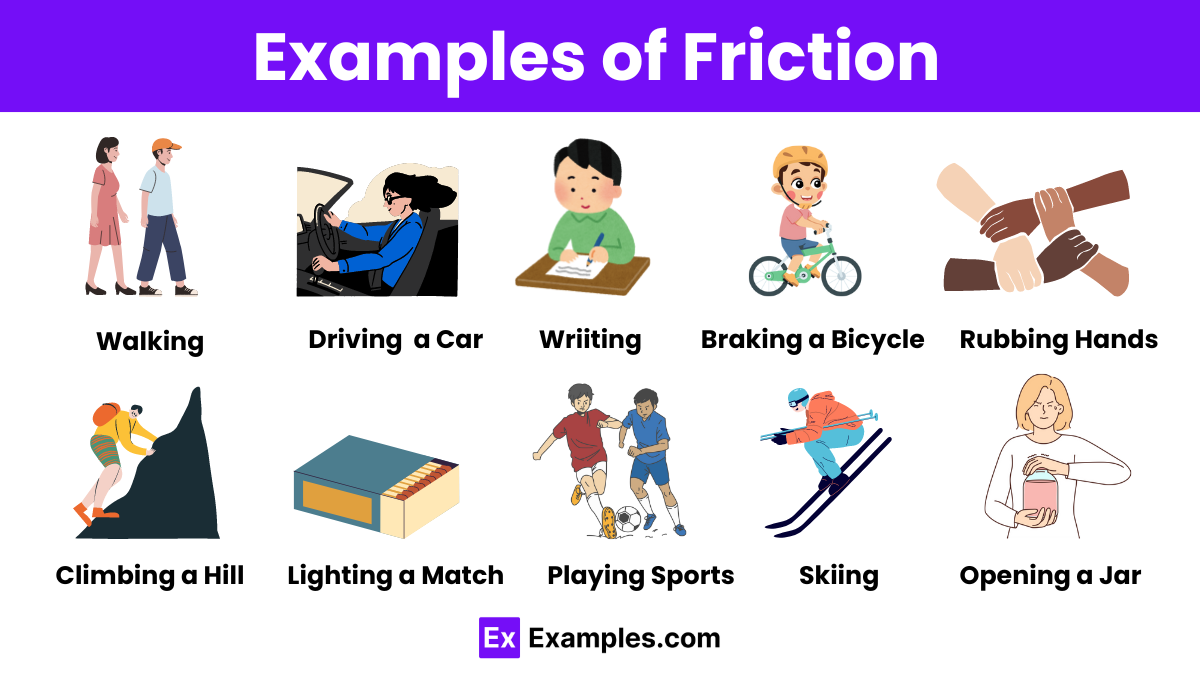Which of the following factors does not affect the coefficient of friction between two surfaces?
Surface roughness
Surface area in contact
Nature of the materials
Normal force


Friction is the resistive force that occurs when two surfaces come into contact and move or attempt to move relative to each other. It acts opposite to the direction of motion and is caused by microscopic interactions between surfaces. Friction enables activities like walking and driving, while also generating heat and causing wear. The friction formula is f = μN, where f is the frictional force, μ is the coefficient of friction, and N is the normal force. The laws of friction state that friction is independent of the contact area and directly proportional to the normal force.
Friction is the resistive force that occurs when two surfaces interact and move against each other. This force opposes the relative motion or the tendency of such motion between the surfaces. It is a crucial factor in everyday life, influencing activities ranging from walking to the functioning of machines. Friction can be classified into several types, such as static, kinetic, and rolling friction, each playing a significant role in various physical phenomena.
The formula for friction depends on the type of friction being considered, but the most commonly used formula is for static and kinetic friction. The frictional force FfF_fFf can be expressed as:
Where:

| Type of Friction | Acts On | Relative Magnitude | Examples |
|---|---|---|---|
| Static | Stationary objects | Highest | Book on a table, heavy box |
| Kinetic | Sliding objects | Moderate | Sliding book, car brakes |
| Rolling | Rolling objects | Low | Soccer ball, bicycle wheels |
| Fluid | Objects in fluids | Variable | Airplane, fish swimming |
Static friction is the force that resists the initiation of sliding motion between two surfaces in contact. For example, when you try to push a heavy box, it doesn’t move until you apply enough force to overcome the static friction between the box and the floor.
Kinetic friction, also known as sliding friction, occurs when two surfaces are already moving relative to each other. For Example, when you slide a book across a table, kinetic friction acts between the book and the table, slowing it down.
Rolling friction is the force resisting the motion when an object rolls on a surface.
An example is when you push a toy car; rolling friction between the wheels and the floor slows it down.
Fluid friction, also known as drag, occurs when an object moves through a fluid, which can be either a liquid or a gas.
For example, when you swim in water, fluid friction acts against your motion, making it harder to move through the water.
Friction is crucial in braking systems, such as car brakes and bicycle brakes. When you apply the brakes, friction between the brake pads and the wheels slows down or stops the vehicle.
Friction between your shoes and the ground allows you to walk or run without slipping. This grip is essential for maintaining balance and movement.
Writing instruments like pencils, pens, and chalk rely on friction between the writing tool and the paper or board. This friction allows the tool to leave a mark.
Friction is used in various manufacturing processes, such as sanding, grinding, and polishing. These processes involve friction to smooth surfaces or shape materials.
Friction plays a significant role in sports. For example, friction between a basketball and the court allows for dribbling, while friction between soccer cleats and the grass provides grip for running and changing direction.
Friction slows down or stops the motion of objects when they rub against each other.
Friction is necessary for everyday activities, like walking, driving, and holding objects.
Friction can be reduced by using lubricants, smoothening surfaces, or using wheels and ball bearings.
Friction produces heat due to the energy conversion from kinetic energy to thermal energy during motion.
The coefficient of friction is a number that represents the friction between two objects, dependent on their materials.
Friction cannot be completely eliminated, but it can be minimized with proper techniques and materials.
Brakes create friction between brake pads and wheels, converting kinetic energy to heat and slowing down the vehicle.
Kinetic friction is the force opposing the motion of two surfaces already sliding past each other.
Friction in machines causes energy loss as heat, reducing efficiency and requiring more energy to maintain motion.
Friction allows athletes to grip surfaces, like shoes on a track, and control movements, like dribbling a basketball.
Text prompt
Add Tone
10 Examples of Public speaking
20 Examples of Gas lighting
Which of the following factors does not affect the coefficient of friction between two surfaces?
Surface roughness
Surface area in contact
Nature of the materials
Normal force
When a block is sliding on a surface with constant velocity, the frictional force is:
Greater than the applied force
Less than the applied force
Equal to the applied force
Zero
What type of friction acts on an object that is not moving but is subjected to an applied force?
Kinetic friction
Static friction
Rolling friction
Fluid friction
Which of the following scenarios involves rolling friction?
A car sliding on ice
A block sliding down a ramp
A ball rolling on the ground
A book resting on a table
If the normal force on an object increases, what happens to the frictional force?
It decreases
It stays the same
It increases
It becomes zero
What is the primary factor that determines the type of friction between two surfaces?
Temperature
Surface roughness
Mass of the object
Speed of the object
Which type of friction is generally less: static friction or kinetic friction?
Static friction
Kinetic friction
They are equal
It depends on the materials
In which direction does friction act relative to the direction of motion?
Parallel and in the same direction
Perpendicular to the direction of motion
Parallel and in the opposite direction
No specific direction
How does lubrication affect friction between two surfaces?
Increases friction
Decreases friction
Has no effect on friction
Makes friction irregular
What is the unit of the coefficient of friction?
Newton
Joule
Unitless
Meter
Before you leave, take our quick quiz to enhance your learning!

